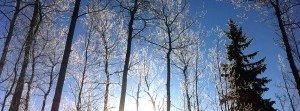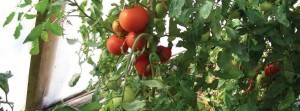
Photo Credit: Amanda Follett
Winterizing northern gardens: Pull ’em out, turn ’em over, tuck ’em in.
“Farmer’s Almanac says it’s going to be a cold winter.”
The avid gardener’s dire predictions for winter were not reassuring. Northern gardeners are often on the edge in terms of preserving perennial plants for the next season. A colder-than-normal winter can be the death of fruit trees or berry bushes or even our ultra-hardy northern rhubarb.
There has always been folklore about winterizing a northern garden, whether it is how to stop plants from freezing or how to be prepared for the next season’s crop. Based on trials and successes of generations of farmers, some of this knowledge is very valid and could save you considerable work during the next growing season.
The need to weed
Why would you want to think about weeds when winter is approaching? Although you may be delighted to see weeds become frozen and brittle as autumn descends down the mountains, late-season weeds left in the garden will come back to haunt you the following summer. Chickweed and lamb’s quarters are introduced European species that thrive in disturbed sites. Being pioneer species, they have the evolutionary strategy of “grow fast, seed fast and leave a seed bank in the soil for the next time it is disturbed.”
If left behind when you harvest, those straggler weeds drop their seeds, which can burst into growth next spring. Effective weed control is based on controlling seed. A garden thoroughly weeded in autumn, before seeds are set, has far fewer weeds to contend with the next year.
Another weed-control method is to turn the soil at the end of the season. Some people leave plant stalks and roots, such as potatoes and cabbages, on the ground. These leftovers not only transmit diseases into next year, the unturned soil harbours young weed plantlets like dandelions. Stems, leaves and roots should be composted, which will diminish the number of disease organisms, and tilling the soil will kill young weeds.
Bare, tilled soil presents a different problem. If the autumn is dry, soil can blow away. Dryness is normally not the problem in northern BC, however, and soil exposed to heavy, pounding fall rainstorms or snow-rain cycles can also suffer losses and damage. In sandy loams, the force of raindrops removes finer soil particles, leaving behind a top layer dominated by infertile sand. On sloped clay soils, rain beating against exposed soil can wash topsoil particles downslope.
Mulch to talk about
If turned soil in autumn is beneficial for weed control, how can erosion and soil damage be controlled? Two effective historic methods of dressing autumn soil were manure and mulching. In the old days, when dairy farms were more common in the Terrace area, manure that had composted over the summer was spread over the fields in the autumn. This allowed the compost to start its work, preparing soil for crops in the spring. Manuring was often followed with a top dressing of composted silage or straw. In the wetter lower Skeena Valley, a coarser surface layer of composted straw fibre lessened damage from heavy rainstorms. Nowadays, be careful to avoid straw or hay contaminated with herbicides like Grazon (See Northword's article on Grazon in the Bulkley Valley).
A layer of grass clippings, flower stalks, leaves or well-composted plant material can protect a tilled garden. I grow heritage dahlias that reach heights of over two metres. Their stems and leaves make excellent mats to protect exposed soil areas. Industrial-grade black polyethylene held down by planks and logs make a complete cover for garden areas and can easily be peeled back in the spring. Black, rather than clear, plastic stops early weed growth before gardening starts.
For perennial plants in untilled locations, exposure to early deep frosts can kill root systems. Snow is an effective insulator against penetrating frosts, but in years when sub-zero temperatures strike before snow coats the ground, protect perennials by mulching with loose straw or leaves. Loose autumn leaves are an effective mulch for roses, rhubarb, strawberries and berry bushes. Non-acidic leaves that compost well, such as maple or birch, do not damage the underlying plants and can be removed in the spring to the compost pile. Avoid mulching with leaves that have acidic or strong decomposition compounds, such as alders or evergreens.
If you live in an area where winter freeze-thaw cycles are limited, mulch can also be used to store root vegetables and seed potatoes within the garden itself. Dig a trench at least 50 cm deeper than average frost level, space the vegetables, cover with dirt, then mound over the top with at least a metre of mulch. The trench will act as a root cellar and the vegetables will be crisp and edible in early spring. If vegetables are wrapped in breathable material, even cabbages can be stored this way. Unless a waterproof cover is placed over top and drainage is excellent, this method does not work well in wetter northern climates.
The weight of winter
For areas of the north that receive deep snowfalls, snow breakage of fruit trees and berry bushes is another significant winter problem. Fruit trees are best pruned with a main leader trunk and side branches, rather than a V shape where snow can accumulate and snap the tree. For berry bushes or new growth of raspberry canes, snow press can destroy berry production for the next year. Staking or caging the branches, wrapping the bushes or tying them to frames can help prevent damage.
Then there is the garden equipment. Store hoses and sprinklers in a space not subject to extreme cold to make plastic last longer. For gardeners who use plank paths between rows, avoid wood rot by stacking planks above wet soil so air can circulate when it is not covered with snow. Wheelbarrows and shovels need to be out of the wet to avoid rusting. Mechanical equipment, such as weed-whackers, pruning saws, clippers and extension cords, will last longer if stored in a basement or barn away from severe sub-zero temperatures.
Regardless of winter weather predictions from Environment Canada or from famous gardening almanacs, preparation of your garden for winter can pay significant dividends. A bit of work after the crops have been harvested will mean less time and effort to grow more food next season.






